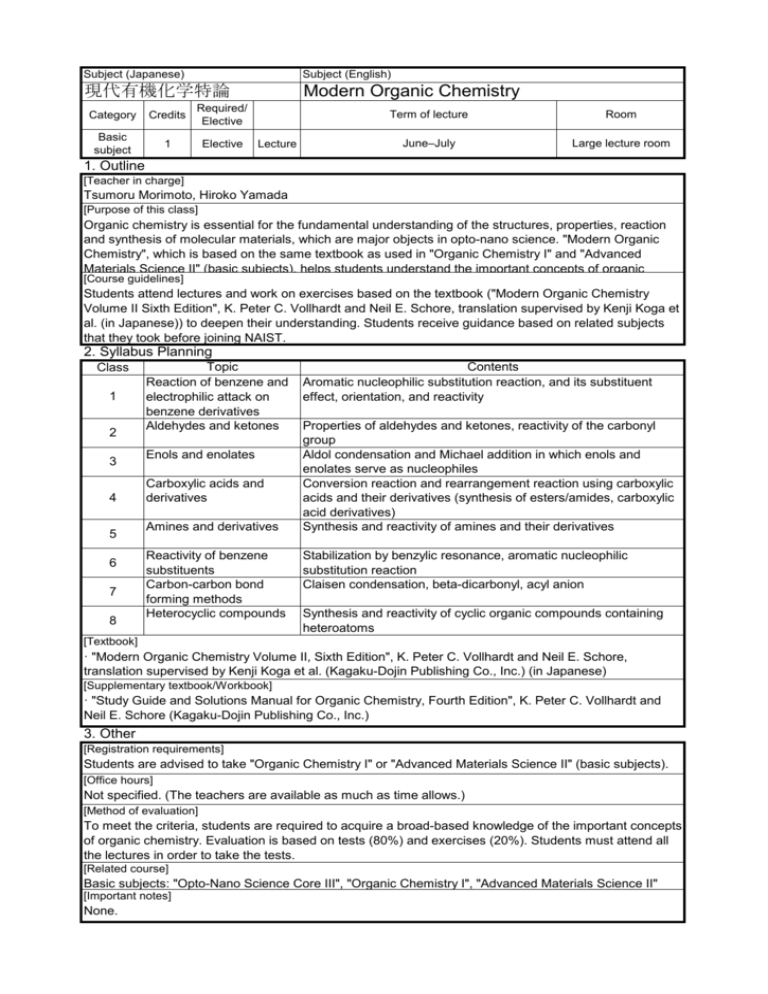現代有機化学特論 Modern Organic Chemistry
advertisement

Subject (Japanese) Subject (English) 現代有機化学特論 Modern Organic Chemistry Category Required/ Credits Elective Basic subject 1 Elective Lecture Term of lecture Room June–July Large lecture room 1. Outline [Teacher in charge] Tsumoru Morimoto, Hiroko Yamada [Purpose of this class] Organic chemistry is essential for the fundamental understanding of the structures, properties, reaction and synthesis of molecular materials, which are major objects in opto-nano science. "Modern Organic Chemistry", which is based on the same textbook as used in "Organic Chemistry I" and "Advanced Materials Science II" (basic subjects), helps students understand the important concepts of organic [Course guidelines] Students attend lectures and work on exercises based on the textbook ("Modern Organic Chemistry Volume II Sixth Edition", K. Peter C. Vollhardt and Neil E. Schore, translation supervised by Kenji Koga et al. (in Japanese)) to deepen their understanding. Students receive guidance based on related subjects that they took before joining NAIST. 2. Syllabus Planning Class 1 2 3 4 5 6 7 8 Topic Reaction of benzene and electrophilic attack on benzene derivatives Aldehydes and ketones Enols and enolates Carboxylic acids and derivatives Amines and derivatives Reactivity of benzene substituents Carbon-carbon bond forming methods Heterocyclic compounds Contents Aromatic nucleophilic substitution reaction, and its substituent effect, orientation, and reactivity Properties of aldehydes and ketones, reactivity of the carbonyl group Aldol condensation and Michael addition in which enols and enolates serve as nucleophiles Conversion reaction and rearrangement reaction using carboxylic acids and their derivatives (synthesis of esters/amides, carboxylic acid derivatives) Synthesis and reactivity of amines and their derivatives Stabilization by benzylic resonance, aromatic nucleophilic substitution reaction Claisen condensation, beta-dicarbonyl, acyl anion Synthesis and reactivity of cyclic organic compounds containing heteroatoms [Textbook] · "Modern Organic Chemistry Volume II, Sixth Edition", K. Peter C. Vollhardt and Neil E. Schore, translation supervised by Kenji Koga et al. (Kagaku-Dojin Publishing Co., Inc.) (in Japanese) [Supplementary textbook/Workbook] · "Study Guide and Solutions Manual for Organic Chemistry, Fourth Edition", K. Peter C. Vollhardt and Neil E. Schore (Kagaku-Dojin Publishing Co., Inc.) 3. Other [Registration requirements] Students are advised to take "Organic Chemistry I" or "Advanced Materials Science II" (basic subjects). [Office hours] Not specified. (The teachers are available as much as time allows.) [Method of evaluation] To meet the criteria, students are required to acquire a broad-based knowledge of the important concepts of organic chemistry. Evaluation is based on tests (80%) and exercises (20%). Students must attend all the lectures in order to take the tests. [Related course] Basic subjects: "Opto-Nano Science Core III", "Organic Chemistry I", "Advanced Materials Science II" [Important notes] None.




